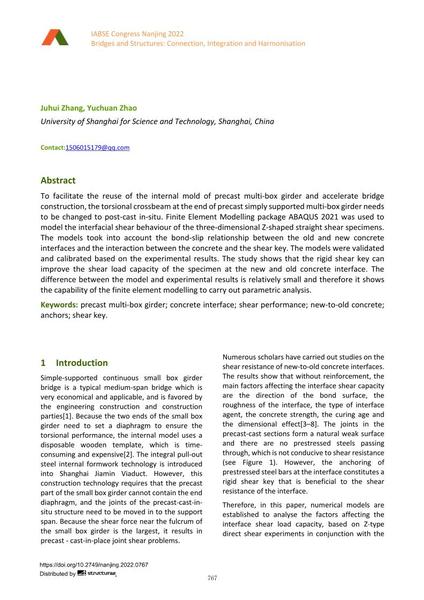FE Modeling of the Interfacial Behaviour of Precast Multi-box Girder

|
|
|||||||||||
Bibliographic Details
| Author(s): |
Juhui Zhang
(University of Shanghai for Science and Technology, Shanghai, China)
Yuchuan Zhao (University of Shanghai for Science and Technology, Shanghai, China) |
||||
|---|---|---|---|---|---|
| Medium: | conference paper | ||||
| Language(s): | English | ||||
| Conference: | IABSE Congress: Bridges and Structures: Connection, Integration and Harmonisation, Nanjing, People's Republic of China, 21-23 September 2022 | ||||
| Published in: | IABSE Congress Nanjing 2022 | ||||
|
|||||
| Page(s): | 767-776 | ||||
| Total no. of pages: | 10 | ||||
| DOI: | 10.2749/nanjing.2022.0767 | ||||
| Abstract: |
To facilitate the reuse of the internal mold of precast multi-box girder and accelerate bridge construction, the torsional crossbeam at the end of precast simply supported multi-box girder needs to be changed to post-cast in-situ. Finite Element Modelling package ABAQUS 2021 was used to model the interfacial shear behaviour of the three-dimensional Z-shaped straight shear specimens. The models took into account the bond-slip relationship between the old and new concrete interfaces and the interaction between the concrete and the shear key. The models were validated and calibrated based on the experimental results. The study shows that the rigid shear key can improve the shear load capacity of the specimen at the new and old concrete interface. The difference between the model and experimental results is relatively small and therefore it shows the capability of the finite element modelling to carry out parametric analysis. |
||||
| Keywords: |
shear key anchors shear performance precast multi-box girder concrete interface new-to-old concrete
|
||||
| Copyright: | © 2022 International Association for Bridge and Structural Engineering (IABSE) | ||||
| License: | This creative work is copyrighted material and may not be used without explicit approval by the author and/or copyright owner. |
||||
